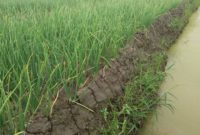Irrigation is the application of controlled amounts of water to plants at needed intervals. Irrigation helps to grow agricultural crops, maintain landscapes, and revegetate disturbed soils in dry areas and during periods of less than average rainfall. Irrigation also has other uses in crop production, including frost protection, suppressing weed growth in grain fields and preventing soil consolidation. In contrast, agriculture that relies only on direct rainfall is referred to as rain-fed or dry land farming.
Irrigation systems are also used for cooling livestock, dust suppression, disposal of sewage, and in mining. Irrigation is often studied together with drainage, which is the removal of surface and sub-surface water from a given area.

Advantages of Irrigation:
1. For proper nourishment of crops certain amount of water is required. If rainfall is insufficient there will be deficiency in fulfillment of water requirement. Irrigation tries to remove this deficiency caused due to inadequate rainfall. Thus, irrigation comes to rescue in dry years.
2. Irrigation improves the yield of crops and makes people prosperous. The living standards of the people is thereby improved.
3. Irrigation also adds to the wealth of the country in two ways. Firstly as bumper crops are produced due to irrigation it makes country self-sufficient in food requirements. Secondly as the irrigation water is taxed when it is supplied to the cultivators, it adds to the revenue.
4. Irrigation makes it possible to grow cash crops which give good returns to the cultivators than the ordinary crops they might have grown in absence of irrigation. Fruit gardens, sugarcane, potato, tobacco etc., are the cash crops.
5. Sometimes large irrigation channels can be used as a means of communication.
6. The falls which come across the irrigation channels can be utilised for producing hydroelectric power.
7. Domestic advantages should not be overlooked. Irrigation facilitates bathing, cattle watering etc., and improves freshwater circulation.
8. Irrigation improves the groundwater storage as water lost due to seepage adds to the groundwater storage.
9. Along the banks of large irrigation channels plantation can be successfully done which not only helps introducing social forestry but also improves environmental status of the region.
10. New irrigation works are started at the time of famines to provide employment to a large number of population. These works are called famine works or relief works.
11. When watering facility is provided to a barren land, the value of this land gets appreciated.
Disadvantages of Irrigation:
1. Excessive seepage and leakage of water forms marshes and ponds all along the channels. The marshes and the ponds in course of time become the colonies of the mosquito, which gives rise to a disease like malaria.
2. Excessive seepage into the ground raises the water-table and this in turn completely saturates the crop root-zone. It causes waterlogging of that area.
3. It lowers the temperature and makes the locality damp due to the presence of irrigation water.
4. Under irrigation canal system valuable residential and industrial land is lost.
5. Initial cost of irrigation project is very high and thereby the cultivators have to pay more taxes in the form of levy.
6. Irrigation works become obstacles in the way of free drainage of water during rainy season and thus results in submerging standing crops and even villages.
